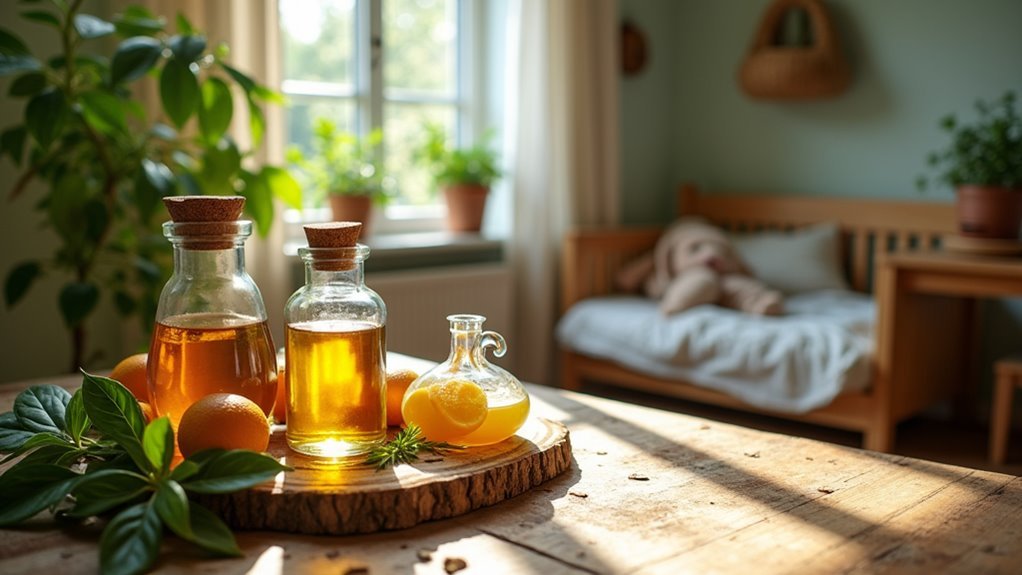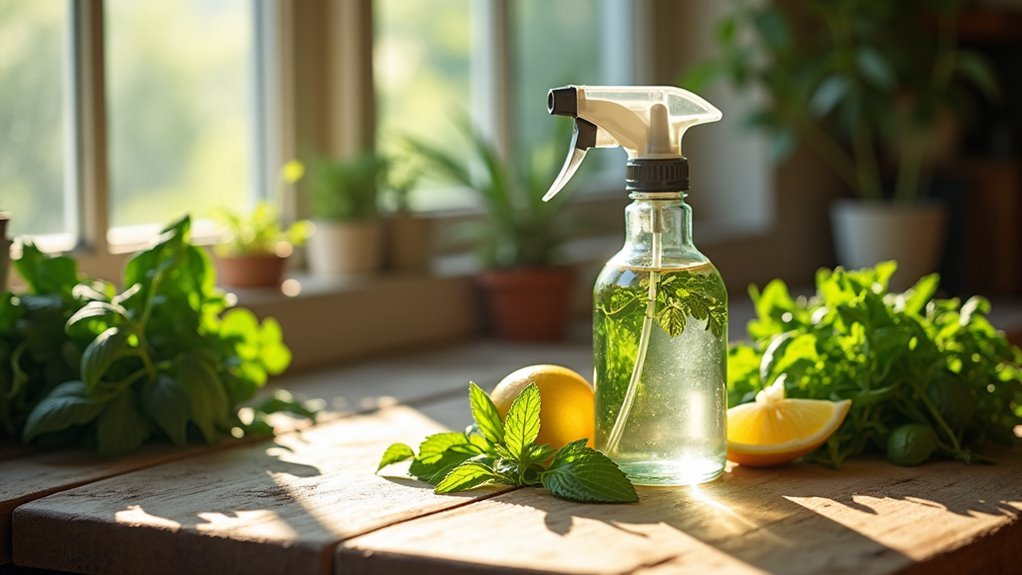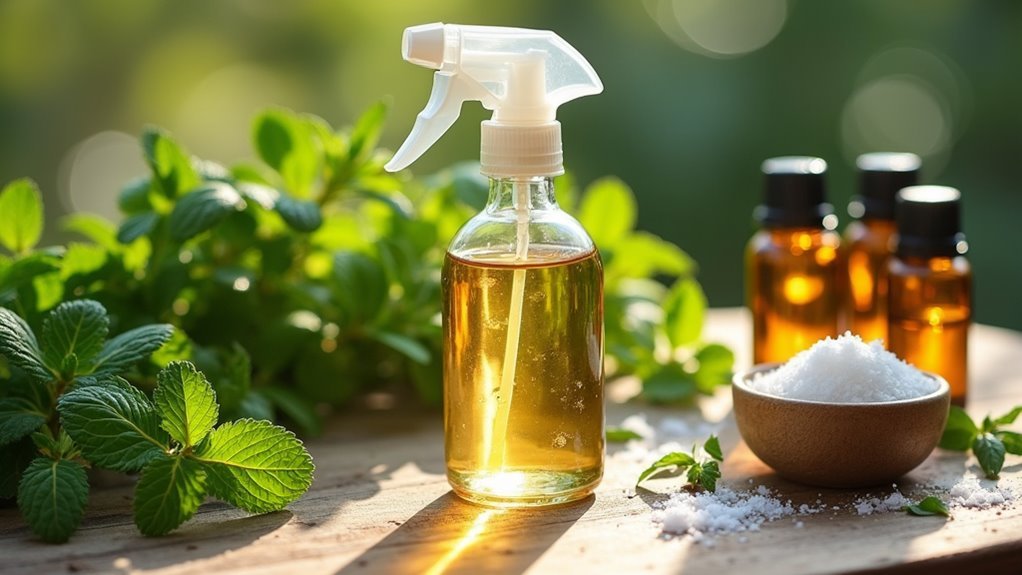You’ll save money and protect your family’s health by making nontoxic spider repellent at home. Commercial pesticides contain harmful neurotoxic chemicals that pose risks to children and pets through ingestion or inhalation, while homemade alternatives using vinegar and essential oils cost under $5 versus $10-20 for store-bought options. Natural ingredients break down quickly without contaminating air or water systems, and you’ll have complete control over what goes into your home’s environment. Discover how simple household staples can effectively keep spiders away.
Safety Benefits for Children and Pets

When you’re dealing with spiders in a home with children and pets, nontoxic spider repellents offer essential safety advantages over chemical pesticides.
Commercial insecticides contain neurotoxic ingredients that pose serious health risks to young children and pets through ingestion or inhalation. By choosing natural ingredients like vinegar and essential oils, you’ll minimize dangerous chemical exposure that can cause respiratory issues, skin irritations, and long-term health problems in sensitive populations.
Creating homemade repellents gives you complete control over ingredients, ensuring you’re avoiding harmful chemicals while effectively managing spider populations.
Natural options like cinnamon essential oil provide proven spider-repelling properties without endangering your household members, allowing you to maintain a safe environment for children and pets.
Cost-Effective Alternative to Commercial Products
You’ll save substantial money by creating your own nontoxic spider repellent instead of purchasing expensive commercial alternatives.
A 16-ounce bottle costs under $5 to make at home, while store-bought versions range from $10 to $20 for the same amount.
You can maximize these savings by buying ingredients in bulk, which reduces the per-use cost even further while ensuring you always have supplies on hand.
Significant Money Savings
One of the most compelling reasons to create your own spider repellent is the dramatic cost savings you’ll experience compared to purchasing commercial alternatives.
You’ll achieve significant money savings since commercial sprays cost $10 to $30 per bottle, while homemade solutions use affordable ingredients you likely already own.
Natural ingredients like vinegar, soap, and essential oils are household staples that cost pennies per application. A single 16-ounce batch provides multiple treatments at a fraction of commercial prices.
You’ll save money by avoiding frequent repurchases that chemical sprays require due to their limited effectiveness. Additionally, you’ll sidestep potential expenses from health issues or property damage that harsh chemicals might cause, making homemade repellents financially advantageous long-term.
Bulk Ingredient Benefits
Beyond the immediate savings from making your own repellent, purchasing ingredients in bulk amplifies these financial benefits even further. You’ll find that bulk ingredients like vinegar and essential oils provide exceptional value for home use, often lasting months while creating multiple batches of effective spider deterrent.
| Bulk Ingredient | Commercial Cost | Bulk Cost | Uses Per Purchase |
|---|---|---|---|
| White Vinegar | $3-4/bottle | $8-10/gallon | 15-20 batches |
| Peppermint Oil | $12/small bottle | $25/large bottle | 50+ batches |
These natural products offer remarkable versatility beyond spider control. You can customize scent strength and effectiveness while choosing an environmentally friendly option that reduces packaging waste. Bulk purchasing transforms simple household ingredients into a sustainable, cost-effective pest management system.
Environmental Impact of Chemical-Free Solutions

When you choose chemical-free spider repellents over conventional pesticides, you’re making a decision that extends far beyond your home’s immediate pest control needs.
Natural repellents crafted from essential oils and vinegar prevent harmful pollutants from contaminating air and water systems, directly supporting environmental health. These nontoxic solutions protect beneficial insects that maintain ecosystem balance, unlike commercial pesticides that indiscriminately harm non-target species.
Your homemade repellents break down quickly in the environment, eliminating bioaccumulation risks that plague synthetic chemicals.
You’ll reduce soil degradation and wildlife harm while decreasing reliance on persistent toxins. Additionally, using biodegradable ingredients minimizes plastic waste from commercial packaging, creating a thorough approach to sustainable living that benefits both your household and the broader environment.
Common Household Ingredients You Already Own
You likely have five powerful spider-repelling ingredients sitting in your pantry and cleaning cabinet right now.
Distilled white vinegar disrupts spiders’ sensory receptors when mixed with water, creating an unwelcoming environment. Your liquid soap enhances any natural spider spray’s effectiveness by helping ingredients stick to surfaces.
Essential oils like peppermint, tea tree, and cinnamon pack serious repelling power—just 30 drops of cinnamon oil in your vinegar solution creates a nontoxic formula that both repels and kills spiders.
Fresh garlic becomes a potent deterrent when crushed and mixed with water.
You’ll also find cedar chips and mint leaves work as natural placement deterrents around your home’s entry points, making spider control surprisingly simple and chemical-free.
Understanding Spider Behavior and Natural Deterrents

Although spiders often trigger fear and disgust, these eight-legged creatures actually prefer avoiding human contact and only bite when they feel cornered or threatened.
Despite their fearsome reputation, spiders are naturally shy creatures that avoid humans and only bite defensively when threatened or trapped.
You’ll find that most common house spiders like American house spiders are non-toxic and actually beneficial since they control insect populations naturally.
Understanding this behavior helps you choose effective natural deterrents instead of harmful chemicals.
Essential oils from peppermint, tea tree, and lavender work exceptionally well because their strong scents disrupt spiders’ sensory receptors.
Vinegar solutions create an equally uninviting environment, as the acidity interferes with their natural behavior patterns.
These natural methods are safer around children and pets while effectively keeping spiders away from your living spaces.
Essential Oils That Effectively Repel Spiders
You’ll find that certain essential oils serve as powerful spider deterrents due to their intense aromas that interfere with spiders’ sensory systems.
The most effective options include peppermint, tea tree, lavender, eucalyptus, and cinnamon oils, each offering unique advantages for your natural pest control arsenal.
Let’s explore which oils work best and how you can apply them strategically throughout your home for maximum spider-repelling effectiveness.
Top Repelling Essential Oils
When it comes to natural spider deterrents, essential oils stand out as powerful allies in your pest control arsenal.
These concentrated plant extracts offer an effective, nontoxic spider solution that’s safe for your family and pets.
Peppermint essential oil tops the list with its overwhelmingly potent aroma that disrupts spiders’ sensory receptors. You’ll find it’s particularly effective when creating homemade repellent sprays.
Tea tree oil doubles as an essential pest fighter, targeting spiders while deterring other household intruders with its powerful natural properties.
Lavender oil provides dual benefits—it’ll repel spiders while creating a calming atmosphere in your home.
Eucalyptus oil rounds out your options, as spiders particularly dislike its scent. When you dilute it with water and spray spider-prone areas, you’re creating an uninviting environment these pests won’t tolerate.
Application Methods and Tips
Transform your home into a spider-free zone by mastering these proven application techniques for essential oil repellents.
You’ll achieve maximum spider control by implementing strategic methods that target spider-prone areas effectively.
Essential Application Methods:
- Create powerful spray solutions – Mix 10-15 drops of peppermint oil with vinegar and water in a spray bottle for potent coverage.
- Target entry points strategically – Focus on windowsills, doorframes, and cracks where spiders typically enter your home.
- Refresh applications regularly – Reapply essential oils every 2-3 days to maintain their repelling strength and effectiveness.
- Combine multiple oils – Blend tea tree, eucalyptus, and lavender for enhanced deterrent properties that spiders absolutely hate.
You’ll notice immediate results when you consistently apply these methods throughout your living spaces.
Vinegar-Based Spray Recipes and Applications
Vinegar’s acidic properties make it one of the most effective natural spider deterrents you can create at home. The acidity disrupts spiders’ sensory receptors, making treated areas uninviting for these pests.
To make your vinegar spray repellent, combine equal parts white vinegar and water in a spray bottle. This simple mixture effectively targets spiders while remaining completely nontoxic for your family and pets.
Apply the solution generously to spider-prone locations like windowsills, doorways, corners, and baseboards. You’ll notice this repellent serves double duty – it cleans surfaces while removing insect trails that attract spiders.
For best results, reapply your vinegar solution regularly, especially after cleaning or when areas become wet. Consistent application maintains the deterrent effect and keeps your home spider-free naturally.
Preventive Measures to Reduce Spider Attraction
While vinegar sprays provide excellent spider deterrence, creating an environment that naturally discourages spiders from entering your home offers even more thorough protection.
These preventive measures for home use work alongside natural repellents to keep spiders away effectively.
Here are four essential strategies to prevent spiders from making your house their haven:
- Clean regularly – Vacuum corners, dust surfaces, and eliminate webs to destroy potential spider habitats that make them feel unwelcome.
- Seal entry points – Caulk cracks around windows and doors to block spider access routes into your sanctuary.
- Store firewood away – Keep wood piles distant from your house to avoid attracting shelter-seeking spiders.
- Control humidity – Use dehumidifiers and avoid overwatering plants to create unfavorable living conditions for spiders.
Identifying When Professional Treatment Is Necessary
While nontoxic repellents work well for minor spider issues, you’ll need to recognize when the situation requires professional intervention.
If you’re noticing a sudden surge in spider sightings that doesn’t decrease despite your prevention efforts, you’re likely dealing with a severe infestation that’s beyond DIY solutions.
Additionally, if you spot dangerous species like black widows or brown recluse spiders in your home, it’s time to call pest control professionals who can safely handle these medically significant threats.
Severe Infestation Signs
Although nontoxic spider repellents work well for minor spider issues, you’ll know it’s time to call professionals when certain warning signs appear throughout your home.
These severe infestation indicators demand immediate attention:
- Multiple webs spanning entire rooms – When you’re constantly walking through thick webs in hallways and living spaces, the population has exploded beyond DIY solutions.
- Daytime spider encounters – Finding spiders in your home during peak activity hours means they’re comfortable and thriving in your space.
- Discovery of spider egg sacs – Especially concerning when you spot venomous spiders like black widows reproducing on your property.
- Medical emergency situations – Spider bites requiring hospital visits signal dangerous species presence.
Contact a pest control company immediately when these scenarios occur.
Dangerous Spider Species
Certain spider species pose genuine health risks that transform a simple pest problem into a potential medical emergency.
Black widows and brown recluse spiders represent the two most dangerous spider species in the U.S., requiring immediate recognition and professional intervention.
You’ll identify black widows by their shiny black bodies and red hourglass markings, while brown recluse spiders display violin-shaped markings on their backs.
Black widow bites cause severe muscle pain and cramping within hours, whereas brown recluse bites create tissue necrosis requiring prompt medical treatment.
When these dangerous species appear, non-toxic spider repellent becomes insufficient.
You need professional pest control services to safely eliminate these threats.
While homemade solutions effectively keep spiders away in general, serious infestations demand expert intervention to protect your family’s health.
Storage and Shelf Life of Homemade Repellents
Once you’ve crafted your homemade spider repellent, proper storage becomes essential for maintaining its effectiveness. Your carefully mixed concoction deserves the right care to preserve its potency and extend its shelf life.
Proper storage is the secret ingredient that keeps your homemade spider repellent working at peak effectiveness.
Here’s how to maximize your homemade repellents’ effectiveness:
- Store in glass containers – Essential oils can degrade plastic, robbing your repellent of its spider-fighting power.
- Keep in cool, dark places – Heat and light break down active ingredients faster than you’d expect.
- Shake before each use – Separation happens quickly, and you’ll need proper mixing for maximum impact.
- Replace every 1-2 weeks – Fresh batches work better than old ones losing their strength.
Watch for unusual odors or appearance changes. When in doubt, make a new batch.
Combining Multiple Natural Methods for Maximum Effect
While individual natural repellents work well on their own, you’ll achieve superior spider control by strategically combining multiple methods into an all-encompassing defense system. This multi-layered approach targets different aspects of spider behavior and physiology, creating an inhospitable environment they can’t adapt to easily.
| Method | Primary Effect |
|---|---|
| Peppermint oil spray | Overwhelms sensory receptors |
| Vinegar solution | Disrupts scent trails |
| Diatomaceous earth | Physical barrier and dehydration |
| Spider-repellent plants | Ongoing natural deterrent |
| Entry point sealing | Prevents initial access |
Regular application of these combined natural methods disrupts spider egg cycles and reduces overall populations. You’ll address both adult spiders and their young while maintaining a safer home environment. This holistic approach guarantees long-term management without harmful chemicals, improving both repellent effectiveness and indoor air quality.
Seasonal Spider Activity and Timing Your Applications
Understanding spider behavior throughout the year enables you to time your natural repellent applications for maximum effectiveness. Seasonal changes dramatically influence when spiders become most active and seek indoor shelter.
Timing your spider repellent applications with seasonal behavior patterns maximizes protection when these pests are most likely to invade your home.
Strategic timing protects your family’s comfort:
- Late summer/early fall – Peak mating season drives spiders indoors
- Early spring – Emerging spiders search for food after hibernation
- Every few weeks – Regular applications during peak seasons prevent infestations
- Monitor temperature/humidity – Environmental factors guide ideal timing
You’ll want to apply repellent proactively before spider activity increases.
During late summer, spiders actively seek warm indoor spaces for mating. Early spring presents another critical window as hungry spiders emerge from winter hiding spots.
Your homemade spider repellent works best when applied consistently every few weeks during these peak periods, creating protective barriers before spiders establish themselves in your home.
Addressing Different Spider Species With Targeted Approaches
You’ll need different strategies for different spider species since each type responds to specific repellent methods.
Common house spiders like American house spiders respond well to habitat disruption, while wolf spiders require essential oil-based deterrents due to their size and behavior patterns.
Medically important species such as black widows and brown recluse spiders need more targeted approaches since they’re typically defensive biters that require careful handling.
Common House Spider Types
Three main spider species typically inhabit homes across North America, each requiring distinct repellent strategies based on their unique behaviors and preferences.
Understanding these common house spiders helps you choose effective methods to keep spiders away from your living spaces.
The primary household pests you’ll encounter include:
- American house spiders – brownish creatures that build webs in room corners, making web-disrupting spider repellent methods most effective.
- Hobo spiders – larger specimens with violin-shaped back markings that respond well to perimeter treatments.
- Wolf spiders – fast-moving hunters that don’t build webs, requiring ground-level deterrent applications.
- All species – generally non-aggressive and prefer avoiding human contact entirely.
Tailoring your repellent approach to each species’ specific habits guarantees you’re addressing the root cause rather than applying generic solutions.
Species-Specific Repellent Methods
While general repellent methods can provide basic protection, each spider species responds differently to specific deterrents based on their unique sensory systems and behavioral patterns.
You’ll find that getting rid of black widow spiders requires peppermint oil, as they’re extremely sensitive to strong scents.
For brown recluse spiders, combine vinegar with essential oils like tea tree or eucalyptus to disrupt their sensory receptors.
American house spiders respond best to cleanliness and decluttering since they prefer dark, undisturbed areas.
You can repel spiders like hobos using diatomaceous earth around hiding spots, which dehydrates them on contact.
Wolf spiders require cinnamon essential oil mixed with vinegar.
These natural spider repellents target each species’ specific vulnerabilities for maximum effectiveness.
Maintaining Long-Term Spider Control Without Chemicals
Achieving lasting spider control doesn’t require harsh chemicals when you implement consistent, natural strategies. By maintaining your home environment and using organic repellent methods, you’ll create an unwelcoming space for spiders without exposing your family to toxic substances.
Natural spider control methods protect your family from both unwanted pests and harmful chemicals while maintaining a clean, comfortable home environment.
Your thorough spider control plan should include:
- Regular cleaning routines – Dusting and vacuuming eliminates spider habitats that make your heart race with unexpected encounters.
- Sealing entry points – Caulking cracks prevents those spine-chilling moments when spiders suddenly appear indoors.
- Natural repellent applications – Vinegar and essential oils disrupt spiders’ senses, giving you peace of mind.
- Strategic plant placement – Lavender and mint create beautiful, aromatic barriers that naturally deter unwanted eight-legged visitors.
Combine these approaches with outdoor maintenance like lawn trimming for maximum effectiveness.
Frequently Asked Questions
What Is a Homemade Non Toxic Spider Repellent?
You can create a homemade nontoxic spider repellent by mixing vinegar, essential oils like peppermint or cinnamon, and liquid soap. This safe combination disrupts spiders’ sensory receptors without harming children or pets.
What Is Safe in Home Spider Repellent?
You can safely use essential oils like peppermint or tea tree, vinegar mixed with water, diatomaceous earth powder, cinnamon oil, garlic, and citrus peels as effective spider repellents.
Does Vinegar Really Repel Spiders?
Yes, vinegar effectively repels spiders by disrupting their sensory receptors. You’ll find that spraying equal parts white vinegar and water in spider-prone areas creates an uninviting environment they’ll avoid.
How Do You Make Homemade Spider Pest Control?
You’ll combine 2 cups distilled white vinegar, 1/4 cup liquid soap, and 30 drops cinnamon essential oil in a 16-ounce spray bottle. Shake well before using on windowsills and doorways.
In Summary
You’ll discover that making nontoxic spider repellent at home protects your family while saving money and reducing environmental harm. You’re using ingredients you already have, understanding spider behavior to target specific species effectively. You’ll combine multiple natural methods and time applications with seasonal activity patterns. You’re maintaining long-term control without exposing children, pets, or the environment to harsh chemicals. You’ve created a sustainable, safe solution that works.





Leave a Reply